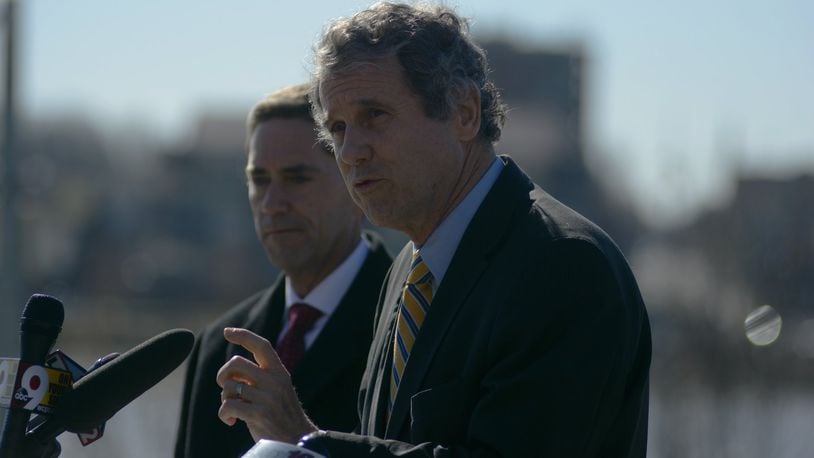RELATED: Cincinnati home to 3 of country’s top traffic ‘bottlenecks’
“We’re overlooking what I hope sooner rather than later is a busy construction site where one of the major public works infrastructure projects in our state and in our nation we hope will take place,” Brown said with several bridges over the Ohio River behind him. “We have all heard these numbers — 160,000 vehicles cross Brent Spence every day. That’s estimated to be somewhere between 2 to 4 percent of GDP (Gross Domestic Product) crosses that bridge every day.”
In the transportation bill passed in 2016, Brown said he included language to ensure major infrastructure projects of critical national significance, such as the 54-year-old Brent Spence Bridge. He said the Brent Spence project has been ranked as one of the top emergency infrastructure projects in the nation.
The latest estimate to replace the Brent Spence Bridge is about $2.6 billion.
He said he was “more optimistic” with transportation and infrastructure improvements moving forward in a Trump Administration but it has to be paid for by new dollars and not unpaid tax breaks.
Brown said he’s “very willing” to work with the Trump and GOP-controlled Congress when its good for Ohio. He said he was willing to work with the Trump Administration on renegotiating NAFTA, pulling out of the Trans Pacific Partnership, and trade enforcement. He said he prefers to pay for infrastructure improvements using overseas dollars that companies have parked their profits, about $3 billion, and bring it back to the U.S. and tax it at a lower rate to fund infrastructure over next five to 10 years. Increasing the federal gas tax is another way that might be used to raise revenues. As for charging tolls, Brown said that was a local decision.
RELATED: Butler County leader to advocate in D.C. for Brent Spence Bridge fix
Brown said he has already met with newly confirmed Transportation Secretary Elaine Chao, the wife of Senate Majority Leader Mitch McConnell, R-Kentucky. He said she understands the importance to both states and the nation as well as needing significant federal investment.
He said since 1980, the nation’s infrastructure has not been maintained and needs to be repaired. Brown called it an opportunity to put people back to work.
Trump promised $1 trillion of investment in American infrastructure during his campaign and Brown joined Senate colleagues to release a road map for making that promise a reality. As part of the plan, Brown included strong Buy America provision to ensure American infrastructure is built by American workers, using American iron and steel. The improvements include improvement’s to the nation’s transportation, water, housing, broadband and other community infrastructure.
While Trump has not yet released his 10-year plan, Brown said, “we’re hopeful they’ll follow something like this. We want to do this bi-partisan. We know that a trillion dollars in infrastructure would put thousands of people to work.”
Brunner said, “any kind of infrastructure investment requires some subsidy whether its federal, state or local… We have to put subsidy in place in order to catalyze private investment back into our region.”
“Infrastructure means jobs. Infrastructure means opportunities. Infrastructure means a high quality of life,” Koehler said. “Those items demand investment in our infrastructure.”
He said members of the OKI board is in Washington this week to meet with legislators.
“Investments in our regional infrastructure not only impacts us here locally but impacts the transportation facilities nationally,” Koehler said.
Other provisions of the blueprint that Brown and Senate Democrats are proposing:
- $200 billion for for a Vital Infrastructure Program (VIP), which would direct money toward projects of critical national significance.
- $210 billion in road and bridge repairs.
- $110 billion to modernize outdated water and sewer systems that would provide communities with grants to help make needed updates to combined sewer overflow systems.
- $130 billion to replace and expand rail and bus systems.
- $75 billion to help modernize America's schools without burdening local taxpayers.
- $100 billion to eliminate blight and lead hazards.
